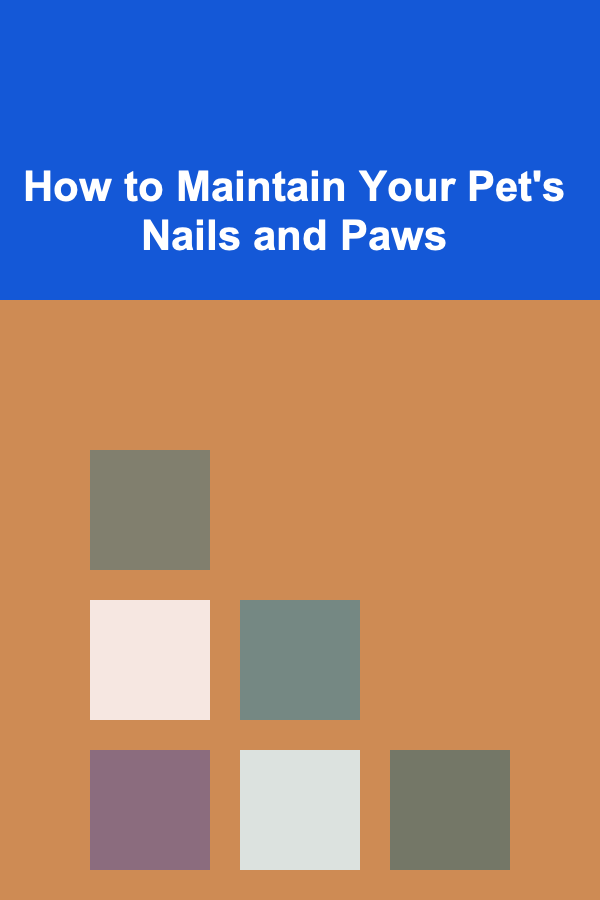
How to Maintain Your Pet's Nails and Paws
ebook include PDF & Audio bundle (Micro Guide)
$12.99$10.99
Limited Time Offer! Order within the next:

As a pet owner, one of the most important responsibilities you have is to ensure that your furry friend is healthy and comfortable. Maintaining your pet's nails and paws is an essential part of their overall well-being. Overgrown nails and neglected paws can lead to a variety of issues, ranging from discomfort to injury, and can even affect their ability to walk and play properly.
This article will delve deep into the importance of nail and paw care for pets, how to properly maintain your pet's nails and paws, common problems that can arise if proper care is not given, and tips for making the process as stress-free as possible for both you and your pet.
Why Nail and Paw Maintenance is Important
Maintaining your pet's nails and paws is not just about appearance -- it's about ensuring their health, comfort, and safety. Let's break down why this care is so important:
1. Nail Health and Comfort
Just like humans, pets use their nails to help with mobility, balance, and traction. Nails that are too long or improperly trimmed can cause discomfort. In extreme cases, they can even grow into the pads of the feet, leading to infections and excruciating pain.
2. Preventing Injury
Overgrown nails can snag on carpets, furniture, and other surfaces, potentially causing painful breaks or tears. Additionally, excessively long nails can alter your pet's walking posture, leading to uneven pressure on their joints and muscles, which can cause long-term health problems, such as arthritis.
3. Proper Paw Maintenance
Paws are crucial to your pet's overall health. They bear the weight of your pet and are exposed to various outdoor conditions, such as rough terrain, dirt, and moisture. Without proper care, their paws can become cracked, infected, or inflamed. Paw pads can also become irritated by substances such as salt or chemicals on the ground, especially in colder climates.
4. Grooming as a Bonding Activity
Regular paw and nail maintenance can also be an opportunity to bond with your pet. This is particularly beneficial for pets who may have behavioral challenges or anxiety. Creating a calm environment where your pet feels comfortable during grooming sessions can enhance trust and understanding between the two of you.
How to Maintain Your Pet's Nails
The key to nail maintenance is consistency. While the frequency may vary based on your pet's breed, activity level, and lifestyle, regular trimming and proper techniques will prevent most nail-related issues. Here are the steps to keep your pet's nails in good condition:
1. Choose the Right Tools
Before you start trimming your pet's nails, you'll need to have the right tools. The most common tools for nail trimming include:
- Nail Clippers: There are different types of nail clippers available, such as guillotine-style, scissor-style, and plier-style clippers. Each has its advantages, so choose one based on your comfort level and the size of your pet's nails.
- Nail Grinder (Dremel): Some pet owners prefer to use a nail grinder instead of clippers. This tool grinds the nail down smoothly and can prevent sharp edges. It can be especially useful for pets that are nervous about the clipping process.
- Styptic Powder: This is essential in case you accidentally cut too deep and cause bleeding. Styptic powder helps stop the bleeding quickly and efficiently.
2. How to Trim Your Pet's Nails
Properly trimming your pet's nails requires precision and patience. Here's a step-by-step guide:
-
Step 1: Get Your Pet Comfortable
Ensure that your pet is calm before you begin. It's best to do this in a quiet environment with minimal distractions. You may want to give them a treat or pet them to help them relax. For cats and smaller dogs, it might be easier to wrap them in a towel, leaving only their paws exposed.
-
Step 2: Examine the Nails
Look closely at the structure of your pet's nails. Pet nails are typically translucent, allowing you to see the "quick" -- the pinkish area inside the nail, which is where the blood vessels and nerves are located. Avoid cutting into this area, as it can cause bleeding and discomfort.
-
Step 3: Trim the Nail
Using the clippers, carefully cut a small portion of the nail. For dogs and cats with dark nails, you should only trim a small amount at a time, as it is more difficult to see the quick. If you're unsure, it's better to trim less than more. If you accidentally cut into the quick, apply styptic powder to stop the bleeding.
-
Step 4: Check the Other Nails
After trimming one paw, move on to the next. It's essential to check all four paws to ensure your pet's nails are properly maintained. If you're not comfortable trimming all the nails at once, break the process into smaller sessions.
-
Step 5: Reward Your Pet
After a successful grooming session, reward your pet with praise or a treat. Positive reinforcement is key to making future sessions go more smoothly.
3. Frequency of Nail Trimming
The frequency of nail trimming depends on your pet's breed, activity level, and the surface they walk on. Dogs and cats that walk on hard surfaces like concrete may naturally wear down their nails, reducing the need for trimming. However, pets that are more indoors or have longer nails may need regular trimming, typically every 3-4 weeks.
Paw Care: Maintaining Healthy Paws
In addition to keeping your pet's nails trimmed, it's important to care for their paws. Let's explore how to properly care for your pet's paws:
1. Clean and Inspect the Paws Regularly
Just like you would check your pet's nails, you should inspect their paws regularly for signs of injury, infection, or irritation. Look for:
- Cuts, scrapes, or abrasions
- Inflammation or swelling
- Foreign objects (e.g., rocks, burrs, or thorns) lodged between the pads
- Cracked or dry paw pads
- Excessive licking or biting of the paws, which can indicate discomfort or infection
If you notice any issues, it's best to consult your vet for proper treatment.
2. Moisturize Dry or Cracked Paw Pads
Pets' paw pads can become dry and cracked, especially in cold weather or after exposure to harsh surfaces. To prevent this, you can use paw balms or moisturizers designed specifically for pets. These products help keep the paw pads soft and prevent cracks that can lead to infection.
- Paw Balm: Apply a small amount of paw balm or petroleum jelly to your pet's paw pads after walks or during cold months. This helps form a protective barrier against harsh conditions.
- Hydrating Paw Soaks: If your pet has dry or cracked paws, a gentle paw soak in warm water mixed with a small amount of coconut oil can help hydrate the pads.
3. Keep Paws Clean
After walks, it's essential to clean your pet's paws to remove dirt, debris, and any potentially harmful substances like salt, chemicals, or pesticides. Simply use a damp cloth or pet wipes to wipe down their paws. If your pet's paws are particularly dirty, a quick rinse in warm water should suffice.
4. Check for Foreign Objects
While walking outdoors, your pet's paws may pick up small rocks, twigs, or other debris. These objects can lodge between the paw pads and cause irritation or discomfort. Always check for anything stuck in the pads after outdoor activities, especially in areas with tall grass or rough terrain.
5. Prevent Paw Pad Injuries
If you live in a region with hot weather, be cautious about walking your pet on pavement during the summer months, as the heat can burn their sensitive paw pads. Similarly, during the winter, snow, ice, and salt can cause irritation. Booties for pets can provide an extra layer of protection during extreme conditions.
6. Trimming the Hair Between the Paws
Some pets, especially long-haired breeds, may have excess hair growing between their paw pads. This hair can trap dirt and moisture, potentially leading to infections. Trim the hair gently with a pair of pet-safe scissors, taking care not to cut the paw pads themselves.
Common Nail and Paw Problems
Even with regular care, pets can encounter nail and paw issues. Here are some common problems to watch out for:
1. Overgrown Nails
Overgrown nails are a common issue, particularly for indoor pets. This can happen if your pet's nails are not regularly trimmed or if they don't get enough exercise on hard surfaces that naturally wear down the nails. Overgrown nails can lead to painful conditions such as ingrown nails or difficulty walking.
2. Ingrown Nails
Ingrown nails occur when the nail grows into the paw pad. This can be painful and lead to infections. If you notice your pet licking or limping due to an ingrown nail, it's important to seek veterinary care.
3. Paw Pad Infections
Paw pad infections can result from cuts, scrapes, or foreign objects trapped in the pads. These infections can lead to swelling, redness, and pus. If you suspect an infection, consult your vet for treatment options.
4. Cracked or Dry Paw Pads
Dry or cracked paw pads can occur due to environmental factors like cold weather, walking on rough surfaces, or frequent exposure to chemicals or salt. Paw balms and moisturizers can help alleviate the symptoms, but severe cases may require veterinary intervention.
Conclusion
Maintaining your pet's nails and paws is an essential aspect of pet care that is often overlooked. Regular nail trimming and paw maintenance can prevent injury, discomfort, and long-term health issues. By using the right tools, establishing a consistent grooming routine, and keeping your pet's paws clean and moisturized, you can ensure that your furry friend stays happy, healthy, and active.
Remember, patience is key -- take the time to ensure that your pet is comfortable during grooming sessions, and always reward them afterward. By making nail and paw care a regular part of your pet's routine, you'll contribute to their overall health and well-being, allowing them to live a long, active, and happy life.
Reading More From Our Other Websites
- [Needle Felting Tip 101] Blooming Creativity: Step-by-Step Guide to Needle-Felting Gorgeous Flowers
- [Survival Kit 101] How to Compile a Survival Kit for Vintage Car Enthusiasts Attending Remote Auto Shows
- [Personal Care Tips 101] How to Optimize Your Sleep Routine for Better Skin and Health
- [Home Holiday Decoration 101] How to Choose the Perfect Christmas Tree Topper Ideas for Your Home's Style
- [Organization Tip 101] How to Store Vintage Clothing to Preserve Quality
- [Home Cleaning 101] How to Tackle Move-Out Cleaning Like a Pro: Get Your Deposit Back Guaranteed!
- [Survival Kit 101] How to Build a Bug Out Bag: Tips for Creating a Life-Saving Emergency Kit
- [Home Family Activity 101] How to Host a Fun and Educational Building with LEGOs as a Family Challenge Night
- [Personal Care Tips 101] How to Use Aftershave to Combat Skin Redness After Shaving
- [Soap Making Tip 101] Best Seasonal Soap Collections: From Spring Lavender to Winter Peppermint

How to Incorporate Seasonal Colors into Your Closet
Read More
How to Involve Children in Time Capsule Creation
Read More
How to Reduce Your Home's Energy Consumption on a Budget
Read More
How to Use Data to Refine and Improve Your Content Strategy
Read More
How to Use LinkedIn to Find Potential B2B Dropshipping Partners
Read More
How to Repair Torn or Damaged Wrapping Paper
Read MoreOther Products

How to Incorporate Seasonal Colors into Your Closet
Read More
How to Involve Children in Time Capsule Creation
Read More
How to Reduce Your Home's Energy Consumption on a Budget
Read More
How to Use Data to Refine and Improve Your Content Strategy
Read More
How to Use LinkedIn to Find Potential B2B Dropshipping Partners
Read More